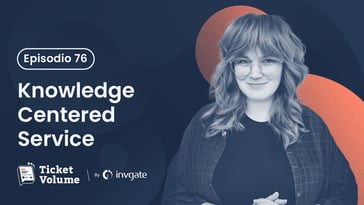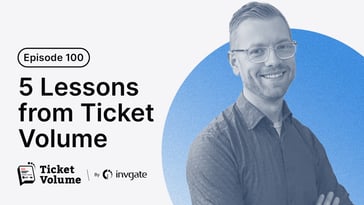The anatomy of an efficient team - it's not just about teamwork, but also about nurturing a healthy team culture, establishing ground rules, and fostering shared core values. But, ever wondered what it takes to build a rock-solid team culture? Or what the secret sauce is behind great leadership? Enter Gregg Gregory, a maestro in the realm of teamwork and leadership, who's got some pearls of wisdom to share.
On the 65th Episode of Ticket Volume, our IT podcast, he broke down the anatomy of an efficient team - it's not just about teamwork, but also about nurturing a healthy team culture, establishing ground rules, and fostering shared core values.
Gregg’s got the recipe for cooking up effective employee training and development strategies, and molding teams that are as cohesive as they are productive. When he's not busy transforming workplaces, you'll find him hosting his podcast "The Teamwork Advantage" or penning down his insights in books like "ONE Team - ONE Dream" and "The GPS of Leadership.
Be sure to catch the full episode featuring Gregory, as he shares what it takes to build effective leadership and the significance of followership.
We'd like to extend an invitation for you to join our monthly live recordings. These aren't just any sessions; they're a platform where you'll have direct access to top professionals in the industry. But it's not just about asking questions. It's also a chance for you to learn from the best, to absorb their wisdom, and to apply it in your own field. When participating, you'll be able to enhance your knowledge and skills, keeping you at the forefront of industry developments.

How to build a team culture from a leadership perspective
Gregory started by explaining the fundamental role of leaders in understanding their team members' unique communication styles and creating an environment that fosters engagement, support, and motivation toward a common goal. He emphasized that leadership is not limited to those in authoritative positions but can be demonstrated by anyone within the organization.
|
|
"They don't have to be in a leadership position to be a leader. Everybody can be a leader. Matter of fact, I think every team has a leader, but that's not always the person who's in charge. And when we stop to think about it, there's a big misconception about self-directed teams, that they don't have a leader. Absolutely a falsity. Please understand, they have a leader. That leader is just kind of guiding the rudder of that ship a little bit if you will. (..) Leaders have the foresight to see a way out mid-range close-up and behind them." Gregg Gregory |
The discussion delved into the crucial components of teamwork, leadership, and culture that collectively form the foundation of an exceptional team. Establishing clear ground rules is essential for enabling teams to function harmoniously and effectively. Furthermore, defining core values and wholeheartedly embracing them is a step toward building a robust team culture.
Shifting the focus to the challenges faced by leaders of technology teams, Gregory highlights the transition from landline to mobile calling as a significant transformation for companies. Leading technology teams requires adeptly navigating and managing various stakeholders, including managers, vendors, and customers. Understanding individual behavior and communication styles is paramount in effectively leading such teams.
In the realm of help desk support, effective communication and the presence of sub-teams with diverse communication styles are key to success. Gregory suggests utilizing the DISC model to tailor communication approaches for tech support professionals.
|
|
"Let's picture a Jihadi window. Four squares. The upper left square, the upper left square that you're looking at is going to be the dominance. That's somebody who's fast-paced, directing to the point. Upper right square would be somebody who's fast-paced but, hey, let's have. Lower right square would be somebody who's still kind of social, high but very slower paced. And then, the lower left square is going to be very detail-oriented. So when you stop to think, are they faster-paced or slower-paced? Are they task-based or are they social-based? When you figure that out, then you know how to communicate with them." Gregg Gregory |
This means that knowing if someone is more social or task-oriented, faster or slower-paced, leaders can tailor their communication to effectively connect with and engage team members. This can be through various mediums like phone calls, in-person conversations, or even emails.
Gregory also offered valuable tips for reducing stress and finding happiness at work. He encouraged individuals to explore stress reduction techniques such as yoga and meditation, taking inspiration from experts in the field.
Don’t forget the next step when building your team
Gregory referred to the bus metaphor in Jim Collins' book "Good to Great", which represents the concept of building a successful team by getting the right people on board and in the right positions. The metaphor suggests that the team is like a bus, with the leader as the driver and the team members as passengers.
The first step is to "get the right people on the bus." This means hiring individuals who not only have the necessary skills and qualifications but also align with the team's values, goals, and culture. It's about finding individuals who are passionate, committed, and driven to contribute to the team's success.
The next step is to "get them in the right seats." This refers to assigning team members to roles and responsibilities that best utilize their skills, strengths, and expertise. It's about ensuring that each person's talents are aligned with their specific role within the team, maximizing their potential and contribution.
However, Gregory mentioned that although everyone he knows in his field remembers the book, the majority of them seem to forget the following:
The bus metaphor also emphasizes recognizing when there are "wrong people on the bus." This doesn't necessarily mean that these individuals are bad or incapable. It simply means that their values, core beliefs, or certain aspects may not align with the team's goals and culture. In order to build a strong team culture, it is crucial to identify and address any mismatches or misalignments, which may involve making difficult decisions such as reassigning or even letting go of certain members.
Overall, the bus metaphor underscores the willingness to address any mismatches in order to build a cohesive and high-performing team culture.
Understanding the “why” to build team culture
In this conversation, they placed special emphasis on the benefits of functioning as a team. Trust, responsiveness, ownership, and a passion for the mission are the hallmarks of successful teams that function with purpose. The result is lower turnover, increased productivity, and a positive team culture.
Gregory underscored the significance of comprehending the "why" behind actions, as it enables leaders to cultivate a positive culture within their teams. Even in times of uncertainty, leaders must continue to guide their teams, relying on a clear mission, vision, and values as their compass.
So much so that when team members understand why their work matters and how it contributes to the overall goals and mission of the organization, they develop a sense of purpose. This clarity helps them stay focused, motivated, and committed to achieving their objectives.
Bottom line
For all you leaders out there, Gregg's got some nuggets of advice - lead with the 'why', stay agile in the face of change, and harness the power of behavior models to structure your team with great metaphors. But this is just a summary of Ticket Volume's episode featuring Gregg Gregory. Be sure to listen to the full discussion with Matt Beran to learn more about his how to build a team culture.
You can find the full episode on popular platforms like Apple Podcasts, Spotify, YouTube, or any other podcast platform you prefer. Remember to subscribe if you're interested in joining the monthly live recordings!















